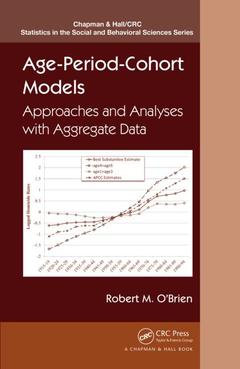Description
Age-Period-Cohort Models
Approaches and Analyses with Aggregate Data
Chapman & Hall/CRC Statistics in the Social and Behavioral Sciences Series
Author: O'Brien Robert
Language: English
Subjects for Age-Period-Cohort Models:
Keywords
APC Model; Null Vector; Statistical Issues of APC Analysis; Cohort Effects; modeling age; period; and cohort effects for aggregate-level data; Intrinsic Estimator; variance decomposition; Estimable Functions; Cohort Characteristics; s-constraint approach; RCS; constrained estimation; Cohort Elements; constrained regression; Period Coefficients; geometry of APC model; Random Period Effects; Dummy Variable Coding; Poisson Random Effects; Homicide Offending; Rank Deficient; Period Life Table; Lexis Diagram; Om Ici; Fixed Effects; AC Model; Age Coefficients; Dummy Variable; Ra Te; Poisson Regression; Age Curve; Cohort Factors
Publication date: 08-2014
Support: Print on demand
Publication date: 06-2020
· 15.6x23.4 cm · Paperback
Description
/li>Contents
/li>Biography
/li>
Develop a Deep Understanding of the Statistical Issues of APC Analysis
Age?Period?Cohort Models: Approaches and Analyses with Aggregate Data presents an introduction to the problems and strategies for modeling age, period, and cohort (APC) effects for aggregate-level data. These strategies include constrained estimation, the use of age and/or period and/or cohort characteristics, estimable functions, variance decomposition, and a new technique called the s-constraint approach.
See How Common Methods Are Related to Each Other
After a general and wide-ranging introductory chapter, the book explains the identification problem from algebraic and geometric perspectives and discusses constrained regression. It then covers important strategies that provide information that does not directly depend on the constraints used to identify the APC model. The final chapter presents a specific empirical example showing that a combination of the approaches can make a compelling case for particular APC effects.
Get Answers to Questions about the Relationships of Ages, Periods, and Cohorts to Important Substantive Variables
This book incorporates several APC approaches into one resource, emphasizing both their geometry and algebra. This integrated presentation helps researchers effectively judge the strengths and weaknesses of the methods, which should lead to better future research and better interpretation of existing research.
Introduction to the Age, Period, and Cohort Mix. Multiple Classification Models and Constrained Regression. Geometry of APC Models and Constrained Estimation. Estimable Functions Approach. Partitioning the Variance in APC Models. Factor-Characteristic Approach. Conclusions: An Empirical Example. Index.
Robert M. O’Brien is a professor emeritus of sociology at the University of Oregon. He specializes in criminology and quantitative methods and has published extensively in both areas. In what is labeled semiretirement, he coedits Sociological Perspectives with James R. Elliott and Jean Stockard and works on research projects.




